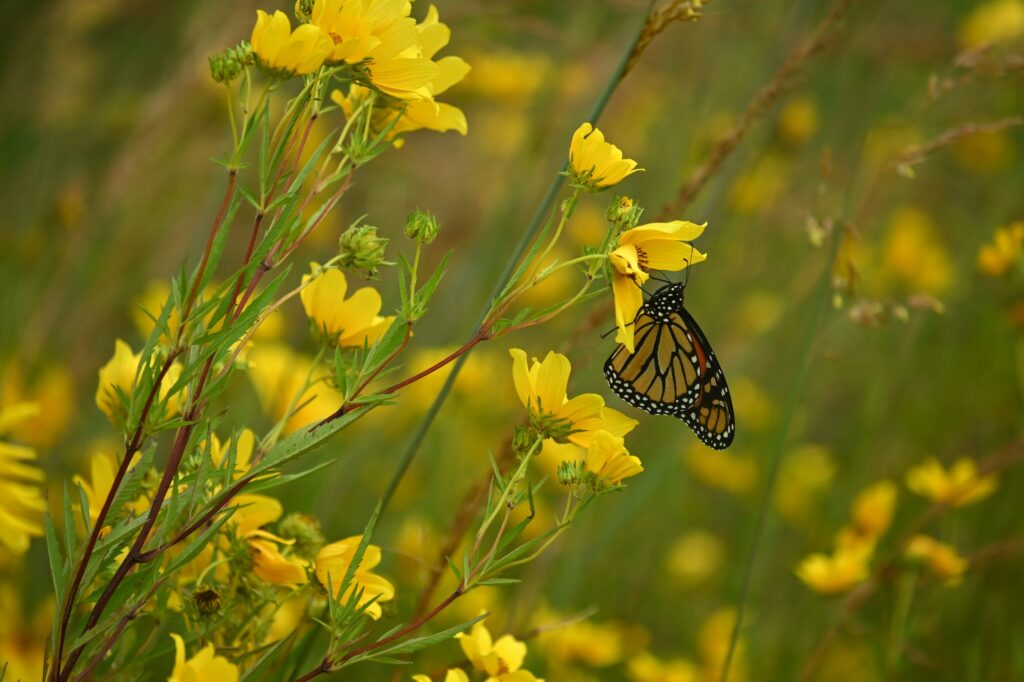
Planting wildflowers can transform almost any landscape into a vibrant and environmentally friendly haven. No matter if it is a spacious garden or a small corner of the yard, adding wildflowers is a simple way to beautify the outdoor space, support local wildlife, and create a natural, low-maintenance oasis.
When planting wildflowers, it’s essential to consider the specific needs of the wildflower species you’re working with, such as soil type, sunlight requirements, and water needs. Additionally, it’s often best to select native wildflowers, as they are adapted to the local climate and provide the greatest benefits for wildlife.
Central Florida is our selection today and we all know it has a warm climate, so look for wildflowers that can thrive in these conditions during the fall season. Keep in mind, Fall in Florida can still get quite warm but here are 10 fall wildflowers that can grow well in Central Florida and why they are suitable:
- Coreopsis (Coreopsis spp.): Coreopsis is well-suited for Central Florida because it’s drought-tolerant and can handle the heat. The bright yellow or orange blooms add a pop of color to a fall garden.
- Tickseed (Bidens alba): This native wildflower produces small white daisy-like flowers and is adapted to Florida’s sandy soils and warm temperatures.
- Blanket Flower (Gaillardia pulchella): The vibrant red and yellow blooms of the blanket flower are a striking addition to your fall garden. They’re also heat and drought-tolerant.
- Firebush (Hamelia patens): Although not a traditional wildflower, the firebush is a great addition to a Florida garden. Its tubular red or orange flowers attract hummingbirds and butterflies.
- Beach Sunflower (Helianthus debilis): This perennial wildflower is well-suited for sandy Florida soil and produces bright yellow flowers throughout the fall season.
- Goldenrod (Solidago spp.): Goldenrod adds a touch of golden-yellow color to the fall landscape, and it’s well adapted to Florida’s climate.
- Seashore Mallow (Kosteletzkya virginica): This native wildflower produces hibiscus-like pink flowers and thrives in the moist conditions that are common in Central Florida.
- Partridge Pea (Chamaecrista fasciculata): A native annual wildflower, partridge pea displays bright yellow blooms and is well-suited for the sandy soils of Florida.
- Liatris (Liatris spp.): Also known as a blazing star or gayfeather, Liatris produces tall spikes of purple or white flowers, adding a vertical element to your garden.
- Milkweed Weed (Asclepias tuberosa): A favorite of butterflies, this native perennial produces clusters of orange or yellow flowers and is adapted to the Florida climate.
These wildflowers are great choices for a Central Florida fall garden because they are adapted to the region’s sandy soil, heat, and humidity. They also provide food and habitat for local wildlife, including pollinators like bees and butterflies.
Here are some general guidelines for where to plant wildflowers:
- Wildflower Gardens: Designate an area in your yard for a dedicated wildflower garden. This could be a small patch, a meadow, or a corner of your garden. Wildflower gardens are ideal for showcasing a variety of wildflowers and creating a more natural, informal look in your landscape.
- Edges and Borders: Plant wildflowers along the edges of your property, along fences, or in border areas to soften the transition between your yard and natural areas. This can create a visually appealing boundary.
- Pollinator Gardens: If your primary goal is to attract pollinators like bees and butterflies, consider planting wildflowers near your vegetable garden or fruit trees. This helps support pollinators that play a crucial role in food production.
- Roadside Planting: In rural areas, consider planting wildflowers along roadsides to create a more attractive and environmentally friendly landscape.
- Native Plantings: Plant native wildflowers in natural areas on your property, such as woodlands, wetlands, or prairies. Native wildflowers are adapted to local conditions and are essential for supporting local ecosystems.
- Containers and Raised Beds: Some wildflowers can be grown in containers or raised beds. This is a good option if you have limited space or poor soil quality in your yard.
- Erosion Control: Wildflowers with deep root systems can be planted on slopes to help control erosion. They stabilize the soil and prevent runoff.
- Cut Flower Garden: Plant wildflowers in a cutting garden if you want to enjoy fresh wildflower bouquets. This is a great way to bring the beauty of the outdoors indoors.
- Bare Spots: Use wildflowers to cover bare or unsightly areas of your yard, such as patches of soil that are difficult to grow grass on.
Incorporating wildflowers into your landscape can have a big impact on your environment and your enjoyment of your outdoor space. By choosing native varieties and carefully considering your planting locations, you can create a flourishing, biodiverse habitat that requires less maintenance and fosters a stronger connection with nature. So, go ahead and start sowing those seeds and watch your garden bloom with the beauty and benefits of wildflowers.
Happy gardening!

